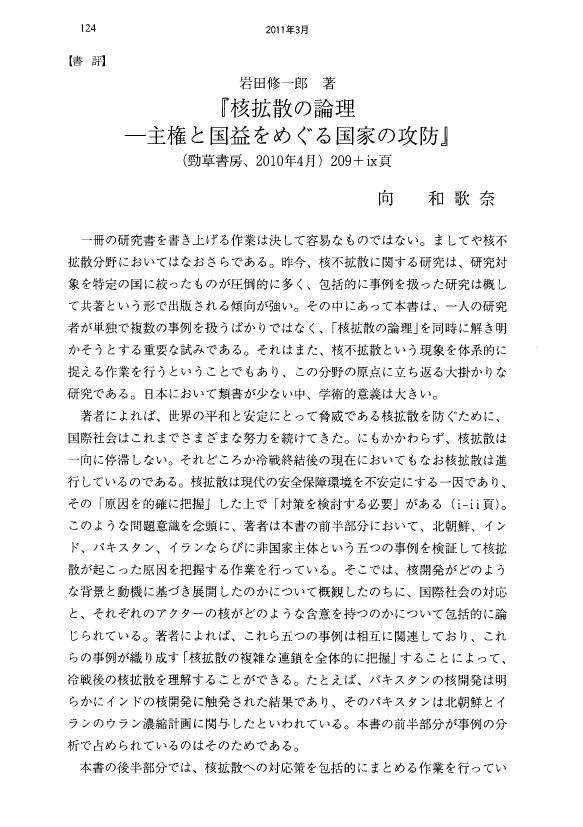1 0 0 0 OA 岩田修一郎 著『核拡散の論理―主権と国益をめぐる国家の攻防』
- 著者
- 向 和歌奈
- 出版者
- 国際安全保障学会
- 雑誌
- 国際安全保障 (ISSN:13467573)
- 巻号頁・発行日
- vol.38, no.4, pp.124-128, 2011-03-31 (Released:2022-04-14)
1 0 0 0 OA 核不拡散体制の逆説的な含意 ―インド核実験を事例として―
- 著者
- 向 和歌奈
- 出版者
- 国際安全保障学会
- 雑誌
- 国際安全保障 (ISSN:13467573)
- 巻号頁・発行日
- vol.35, no.4, pp.51-67, 2008-03-31 (Released:2022-04-20)
- 著者
- リファート・フセイン 向 和歌奈
- 出版者
- 国際安全保障学会
- 雑誌
- 国際安全保障 (ISSN:13467573)
- 巻号頁・発行日
- vol.35, no.2, pp.35-55, 2007-09-30 (Released:2022-04-20)
1 0 0 0 核軍縮の試みに見る核抑止概念の固定化への一考察
- 著者
- 向 和歌奈
- 出版者
- 一般財団法人 日本国際政治学会
- 雑誌
- 国際政治 (ISSN:04542215)
- 巻号頁・発行日
- vol.2021, no.203, pp.203_63-203_79, 2021-03-30 (Released:2022-03-31)
- 参考文献数
- 43
There seems to be a tendency that nuclear disarmament and nuclear deterrence have been treated as contradictory concepts. Those who have advocated nuclear disarmament, and ultimately the elimination of nuclear weapons, have claimed that the idea of nuclear deterrence has long been an obstacle for the further progress of nuclear disarmament. Likewise, promoters of nuclear deterrence consider the concept itself as an important mechanism to enhance international peace and security, and thus tend to neglect the idea of nuclear disarmament. In other words, the two concepts are on the opposite ends of the spectrum.At the same time, it is also possible to point out that the concept of deterrence and disarmament have long been inseparable, and that the two have progressed in parallel with each other. In other words, the promotion of nuclear disarmament has, in some cases, reinforced the concept of nuclear deterrence.In the early ages of the Cold War, the United States and the Soviet Union experienced a period in which the two countries were contemplating the idea of a General and Complete Disarmament (GCD) with specific proposals for a treaty to initiate the concept. Both the United States and the Soviet Union craved for international support to let the world know that they were seriously thinking of how to ultimately avoid war. On the other hand, the two countries recognized from an early stage that it was nearly impossible to reach an agreement on GCD, and the two moved in the direction of a search for multilateral arms control agreements, resulting in the creation of the Partial Nuclear-Test-Ban Treaty (PTBT) and the Treaty on the Non-Proliferation of Nuclear Weapons (NPT).Both the PTBT and the NPT contributed in securing the nuclear status of the already-nuclear possessing states at that time. The two treaties were attempts by the already-nuclear possessing states to dominate nuclear weapons, which were considered as signs that nuclear deterrence does matter in international politics. This prompted discontent among the nuclear threshold states, which eventually led them to acquire their own nuclear weapons.The indefinite extension of the NPT, the creation of the Comprehensive Nuclear-Test-Ban Treaty (CTBT) and the Treaty on the Prohibition of Nuclear Weapons (TPNW) were cases in which the importance of nuclear weapons and nuclear deterrence were more explicitly and implicitly advocated by countries that do not possess nuclear weapons. The TPNW which stigmatizes nuclear weapons made the gap between the so-called “deterrers” and “disarmers” even more solid. Moreover, it reminded the international community that not only countries that possess nuclear weapons but also countries that are under the nuclear umbrella regard nuclear deterrence too important to let go, even being accused of not being faithful to the promotion of nuclear disarmament.
- 著者
- 向 和歌奈
- 出版者
- 国際安全保障学会
- 雑誌
- 国際安全保障 (ISSN:13467573)
- 巻号頁・発行日
- vol.46, no.4, pp.93-97, 2019-03-31 (Released:2022-03-14)


